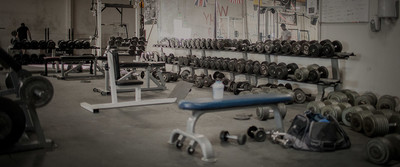In this article I am going to outline a simple, but effective short term plan, that will enable you to add some pretty impressive weight to your bench press in a relatively short period of time. I have used this training protocol for many years, at various times, when I needed to add some poundage to my benching. So far, it has never failed me!
First of all, let me say that while performing bench presses, you should always use a spotter, for safety's sake. Too many people get hurt every year, for attempting to go too heavy without a spot.
Play it safe, and don't be shy, or afraid to ask for a spot if you train alone... you will not regret it, as rolling a heavy weight down the ribcage to the thighs, and then sitting up with the weight in your lap, can leave some pretty mean tracks!!
The basic premise of the routine is progressive overload, meaning that every week you are putting greater amounts of stress on the muscles used in bench pressing. You do this by adding small amounts of weight to the bar on a weekly basis.
This progressive overload forces the body to grow so it can adapt to the ever increasing amount of stress you are creating weekly—even though you are not quite training to failure, except for on the last few sets (in most cases anyway)—if, of course you are performing the routine correctly.
When benching the eyes should be right below the bar, shoulder blades squeezed together, chest held high, and inflated, a slightly arched back, and feet should be placed firmly on the floor. This will give you a good base of power to push off from.
Slowly bring the bar down to nipple level, touching the chest, and "Hyper explode" pushing the bar upward and backward in kind of a small arc.
Of course where you touch your chest with the bar will vary from person to person...the key is to just make sure it feels natural, and doesn't place too much unwanted stress on the shoulders.
How It Works
There are no fancy formulas, graphs or charts involved in this setup, it's just 5 sets of 5 reps on the bench press... after a warm-up set or two to avoid injury, and to prepare the body for the heavier sets to follow.
Effective Progression
The whole key to doing this program effectively, is to start out with a much lighter weight than you would normally use for benching.
For example, if you can bench press 225 pounds for a hard set of 5 reps, then you should start the program using only 185 pounds for the 5 sets of 5 reps.
The reasons for this are, that if you let your ego take over and begin the program using a weight that is too heavy, you will plateau, or burn out very quickly, and using the lighter weights to start with, will help you to perfect your form, while increasing poundage weekly.
End result, heavier reps with textbook form, which is imperative if you want to avoid injury, and work the target muscles involved in performing the exercise.
OK, lets assume that you begin the program using 185 pounds, this is all hypothetical, but no matter what you are benching presently, start off using considerably less weight. This is very important for long term progress, and to make this program work effectively for you.
If you do all 5 sets of 5 reps with the 185 pounds, then you will add 5 pounds to the bar the next time you bench.
You should only be benching once a week, and although the first few weeks will feel easy for you, by the time you get to week 3 or 4 you will be hard pressed to get all the reps on the latter sets.
That is 2 1/2 pounds to each side of the bar just to clarify!!
You keep adding this 5 total pounds weekly, until you hit a sticking point and begin to plateau.
If at any time you do not complete all of the sets and reps, stay at this weight until you succeed, then continue on by adding the 5 pounds on the following bench day, after you have succeeded with the weight that gave you trouble.
Warming Up
Warm-up sufficiently by doing a lighter set or two, but do not overextend yourself on these sets... just make sure it prepares you for the heavier 5 work sets to come later.
Obviously, if you are benching in the neighborhood of 300-400 pounds for sets of 5 reps, you will have to do progressive jumps in poundage to warm-up good enough, but still, do not go overboard. Try to save power for the hard stuff!
After a time, you will eventually hit a wall, and will be able to progress no further, just as you would on any program. This is where I recommend warming up, and performing either 3 sets of 3 reps or, 5 sets of 3 reps with a heavier poundage of course.
I personally would recommend opting for the former scenario for most trainees, but if you can handle 5 sets, then by all means go for it!!
You'll soon be repping out with way more weight in no time flat. Remember to throw away your ego, and intentionally start out at lighter weights—I can't stress the importance of this strongly enough.
Assistance Exercises
Good assistance exercises to use are barbell inclines, and weighted parallel bar dips, along with some lat work, and tricep training to aid in pushing power.
A good exercise to help strengthen the front deltoid (which is heavily involved during benching), is to do front raises while holding an Olympic plate (to face level only is sufficient) using two hands.
Jim Williams, who was one of the first men to bench press 700 pounds, did a lot of these "plate raises," and this was in the 1970's (long before bench shirts were invented).
You can also do this type of training regimen using any one of the big compound exercises or a combination of a few at a time. It works great on squats, deadlifts, barbell rows, inclines, etc. etc.

